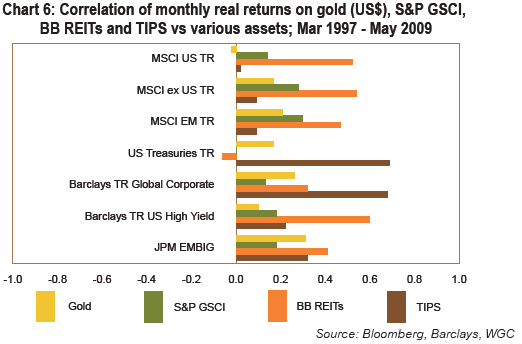Tactical Inflation Hedging
Post on: 16 Июль, 2015 No Comment

The prospect for a resurgence in inflation looks high. The aggressive policy responses put in place around the world to deal with the financial crisis combined with the emerging green shoots that signal a fading recession have investors concerned with how to protect their assets in an environment of rising prices.
However, inflation isn’t here yet and may be delayed for the foreseeable future if the world’s central bankers can pull off the high wire act of reigning in the money supply without choking off the economic recovery.
These are the questions that the World Gold Council (WGC) recently asked in evaluating four traditional assets that are perceived to perform well during a high inflation environment.
The study’s authors set out to determine if it is possible to demonstrably enhance investors risk-adjusted returns in a low to medium inflation environment, yet provide investors with the peace of mind that they have an asset in their portfolio that is likely to outperform should inflation materially accelerate.
Comparing Inflation Hedging Tools
The WGC study compares traditional inflation hedges — gold, commodities, real estate and treasury inflation-protected securities (TIPs) — across three historical periods and one forecast scenario using conservative real return assumptions.
The study finds that in two of the three historical scenarios, gold proved more effective than commodities, real estate and TIPS, at achieving both the maximum reward-risk portfolio and the minimum-variance portfolio.
Real Returns
The specific assets WGC analysts chose to represent their respective asset classes include the spot price of gold (US$/oz), at 5 pm in New York, the S&P GSCI. a production-weighted commodities index that is commonly used by institutional investors, the Bloomberg Real Estate Investment Trust Index (BB REITs), a capitalization-weighted index of Real Estate Investment Trusts having a market capitalization of US$15 million or greater; and Barclays Aggregate US Treasury Inflation-Protected Securities Index (TIPS).
The performance of the assets are compared over three distinct periods: 1974 2009, 1993 2009 and 1997 2009.
In the longest time period, 1974 — 2009, commodities outperform gold from a real return perspective with annualized real returns of 2.8% and 2.0% respectively. REITS and TIPS are not included due to a lack of data going back to 1974. In the 1993 — 2009 period, the study finds gold (+3.6%) outperforming commodities (+2.1%) and real estate (-2.1%). In the final period, 1997 — 2009, gold is the strongest performer (+5.9%) followed by TIPS (+3.7%). Commodities are flat (-0.2%) in this period while real estate again underperforms (-3.8%).
Portfolio Diversification
The study also evaluates the correlation of the inflation hedging tools with stocks and bonds to determine diversification effectiveness. Over the longest time period, gold and commodities show little correlation with the major asset classes in both the US and World ex US.
In the second time period, real estate performs poorly as a portfolio diversifier (correlation over 0.4) while gold and commodities maintained low correlations with stocks and bonds (0.2 and below).
In the final time period, TIPS proved to be highly correlated (0.7) with US Treasury and corporate bonds and maintained an average correlation of 0.3 with stocks and bonds overall. Real estate again had the highest correlation of the group (0.4) while gold and commodities maintained average correlations below 0.2.

Optimal Allocations
The study authors conclude with evaluating return, volatility and diversification potential together to determine the optimal portfolio allocations.
The authors conclude that in the longest time period, adding either gold or commodities improved the risk-adjusted returns. Commodities slightly outperform gold in the first time period with optimal allocations of 6.9% (maximum risk-reward) and 9.4% (minimum variance). Gold outperforms commodities in the second and third time periods.
Over all three time periods, the required allocation to gold in the portfolio mix to attain minimum variance ranged from 4.0 to 6.3%, while the allocation required to achieve the maximum reward-risk ranged from 7.0 to 9.9%.
A 6.9% allocation to gold also produced the highest reward-risk portfolio in the forecast scenario, while an allocation to TIPS produced the lowest variance portfolio.
www.gold.org.
Inflation Hedging with ETFs
The largest gold ETF is SPDR Gold Shares (GLD). The $32 billion ETF is designed to reflect the performance of the price of gold bullion. Other gold ETFs include the iShares COMEX Gold Trust (IAU) and DB Gold Fund (DGL) .














